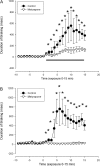Role of metabolic activation and the TRPA1 receptor in the sensory irritation response to styrene and naphthalene
- PMID: 20176620
- PMCID: PMC2948824
- DOI: 10.1093/toxsci/kfq057
Role of metabolic activation and the TRPA1 receptor in the sensory irritation response to styrene and naphthalene
Abstract
The current study was aimed at examining the role of cytochrome P450 (CYP450) activation and the electrophile-sensitive transient receptor potential ankyrin 1 receptor (TRPA1) in mediating the sensory irritation response to styrene and naphthalene. Toward this end, the sensory irritation to these vapors was measured in female C57Bl/6J mice during 15-min exposure via plethysmographic measurement of the duration of braking at the onset of each expiration. The sensory irritation response to 75 ppm styrene and 7 ppm naphthalene was diminished threefold or more in animals pretreated with the CYP450 inhibitor metyrapone, providing evidence of the role of metabolic activation in the response to these vapors. The sensory irritation response to styrene (75 ppm) and naphthalene (7.6 ppm) was virtually absent in TRPA1-/- knockout mice, indicating the critical role of this receptor in mediating the response. Thus, these results support the hypothesis that styrene and naphthalene vapors initiate the sensory irritation response through TRPA1 detection of their CYP450 metabolites.
Figures


Similar articles
-
Sensory detection and responses to toxic gases: mechanisms, health effects, and countermeasures.Proc Am Thorac Soc. 2010 Jul;7(4):269-77. doi: 10.1513/pats.201001-004SM. Proc Am Thorac Soc. 2010. PMID: 20601631 Free PMC article. Review.
-
Menthol attenuates respiratory irritation responses to multiple cigarette smoke irritants.FASEB J. 2011 Dec;25(12):4434-44. doi: 10.1096/fj.11-188383. Epub 2011 Sep 8. FASEB J. 2011. PMID: 21903934 Free PMC article.
-
Transient receptor potential ankyrin 1 mediates toluene diisocyanate-evoked respiratory irritation.Am J Respir Cell Mol Biol. 2009 Jun;40(6):756-62. doi: 10.1165/rcmb.2008-0292OC. Epub 2008 Dec 4. Am J Respir Cell Mol Biol. 2009. PMID: 19059884 Free PMC article.
-
TRPA1 channel in the airway underlies protection against airborne threats by modulating respiration and behaviour.J Physiol. 2024 Oct;602(19):4755-4762. doi: 10.1113/JP284076. Epub 2023 May 14. J Physiol. 2024. PMID: 37147468 Review.
-
Adenosine sensory transduction pathways contribute to activation of the sensory irritation response to inspired irritant vapors.Toxicol Sci. 2006 Oct;93(2):411-21. doi: 10.1093/toxsci/kfl061. Epub 2006 Jul 13. Toxicol Sci. 2006. PMID: 16840565
Cited by
-
Sensory detection and responses to toxic gases: mechanisms, health effects, and countermeasures.Proc Am Thorac Soc. 2010 Jul;7(4):269-77. doi: 10.1513/pats.201001-004SM. Proc Am Thorac Soc. 2010. PMID: 20601631 Free PMC article. Review.
-
Activation of TRPA1 by volatile organic chemicals leading to sensory irritation.ALTEX. 2019;36(4):572-582. doi: 10.14573/altex.1811012. Epub 2019 Apr 18. ALTEX. 2019. PMID: 31026039 Free PMC article.
-
Structure-toxicity relationship study of para-halogenated styrene analogues in CYP2E1 transgenic cells.Toxicol Lett. 2012 May 5;210(3):353-9. doi: 10.1016/j.toxlet.2012.02.008. Epub 2012 Feb 16. Toxicol Lett. 2012. PMID: 22366341 Free PMC article.
-
Naphthalene: irritative and inflammatory effects on the airways.Int Arch Occup Environ Health. 2021 Jul;94(5):889-899. doi: 10.1007/s00420-020-01636-0. Epub 2021 Jan 19. Int Arch Occup Environ Health. 2021. PMID: 33462664 Free PMC article.
-
Electrophilic components of diesel exhaust particles (DEP) activate transient receptor potential ankyrin-1 (TRPA1): a probable mechanism of acute pulmonary toxicity for DEP.Chem Res Toxicol. 2011 Jun 20;24(6):950-9. doi: 10.1021/tx200123z. Epub 2011 May 25. Chem Res Toxicol. 2011. PMID: 21591660 Free PMC article.
References
-
- Abraham MH, Kumarsingh R, Cometto-Muniz JE, Cain WS. An algorithm for nasal pungency thresholds in man. Arch. Toxicol. 1998;72:227–232. - PubMed
-
- Alarie Y. Sensory irritation by airborne chemicals. CRC Crit. Rev. Toxicol. 1973;2:299–363. - PubMed
-
- Alarie Y, Schaper M, Nielsen GD, Abraham MH. Structure-activity relationships of volatile organic chemicals as sensory irritants. Arch. Toxicol. 1998;72:125–140. - PubMed
-
- Baldwin RM, Schultz MA, Buckpitt AR. Bioactivation of the pulmonary toxicants naphthalene and 1-nitronaphthalene by rat CYP2F4. J. Pharmacol. Exp. Ther. 2005;312:857–865. - PubMed
MeSH terms
Substances
Grants and funding
LinkOut - more resources
Full Text Sources
Molecular Biology Databases

